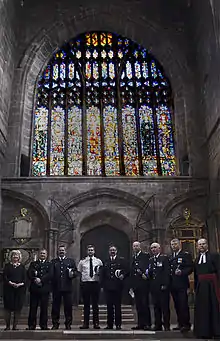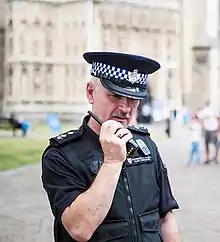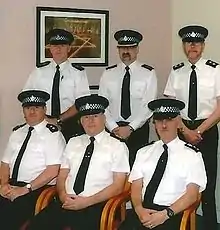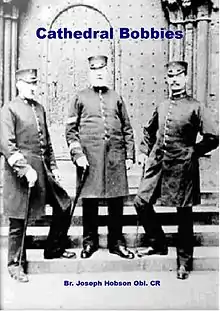Cathedral constable
Cathedral constables are employed by a small number of Church of England cathedrals in England.[1] They have been appointed under common law and cathedral statutes (ecclesiastical law) for nearly 800 years, predating the modern police service by many centuries.

History
Cathedral constables have a long history and can trace their lineage back to the 13th century. They have played an important, if little known, contribution in the development of policing in the United Kingdom.
Before the onset of professional policing something often overlooked is the close relationship which once existed between the church and the imposition of law and order. In the Middle Ages the parish was the smallest unit of local government in the country. Every parish was centred around the local church, and after the Reformation was responsible for administering civil and religious government at a local level. Many parishes developed a vestry – a small body of village officials, answerable only to the bishop and the local justices, and who were responsible for the ecclesiastical and secular well being of the parish they served.
Parish constables, sometimes referred to as petty constables, were attested by justices of the peace but accountable to the local churchwardens. Like parish constables, church wardens were locally appointed and oversaw the administration of the parish, good order during services, and the upkeep of the church fabric and property. Similarly, many cathedrals employed constables to keep watch and maintain law and order within the cathedral and its precincts; an area often known as the Close. These officers were appointed by, and answerable to, the cathedral Dean and Chapter.
Current operations


Constables are employed at four cathedrals:
- York Minster Police at York Minster
- Liverpool Cathedral Constables at Liverpool Cathedral
- Canterbury Cathedral Close Constables at Canterbury Cathedral
- Chester Cathedral Constables at Chester Cathedral
During the 21st century constables have also operated at:
- Salisbury Cathedral Constables (abolished 2010)
- Hereford Cathedral Constables (abolished 2014)
Training, equipment, and uniform
Cathedral constables wear a uniform very similar to British territorial police forces.
Attestation
Some officers are attested and hold the office of constable within the cathedral's curtilage, whilst others remain un-sworn. Constables who are attested wear a distinguishing royal blue and white Sillitoe tartan chequered cap band to distinguish them from their Home Office police colleagues (black and white chequered cap band) and their un-sworn colleagues (plain hat bands).
A number of officers at Canterbury, York, Liverpool and Chester are attested and hold the powers of constable in their respective cathedral and precincts. Newly appointed officers undertake pre-attestation training (provided by the CCA) together with training delivered by their own cathedral. Upon completion, officers are attested and can undertake Officer Safety Training (OST).[2]
Chief Officers
Most of the current constabularies distinguish their chief officer with the rank markings used by a police Inspector in a territorial force. This officer generally bears the title "Head Constable" or "Inspector". There is a formal command structure in each constabulary of Chief Inspector (Canterbury Cathedral only), Inspector, Sergeant, Constable and unattested Warden. The position of "Chief Officer" exists within the Cathedral Constables' Association (CCA).[3]
Training
Local training is supplemented by training opportunities organised by the CCA, including the level 3 Certificate in Cathedral Constable Attestation (see below), and individual personal safety training (PST) which is provided under contract by training officers of the Mersey Tunnels Police.[4]
In 2018/2019 two officers, Chief Inspector Jim Morley (Canterbury Cathedral) and Cathedral Constable Adam Rickers (York Minster), were recognised nationally for their bravery in saving life by the Royal Humane Society.
Cathedral Constables' Association

In order to advance professional development within the constabularies, as well as sharing best practice, providing channels of mutual cooperation, and preserving the history and traditions of cathedral policing, the Cathedral Constables' Association was formed by senior officers. Their motto 'In Deo Speramus' means 'In God we trust.' The association has published a short book 'Cathedral Bobbies' outlining the history, traditions, and work of cathedral constables.

The association, working with the national awarding body NCFE, has developed the level 3 Certificate in Cathedral Constable Attestation (CCCA). The award is aimed at serving officers who want to be considered for attestation. The CCCA is divided into seven units supporting knowledge and development in areas including conflict management, incident response, evidence and crime scene management, arrest and detention, offences against property, people, and public order, and PACE. Additionally, the association has become a registered centre with NCFE, allowing it to offer other qualifications accredited by the awarding body. The CCA has additionally forged links with the College of Policing and National Police Chiefs' Council (NPCC).
The association's patron is the former Metropolitan Police Commissioner Lord Ian Blair Kt QPM.
See also
References
- Cathedral constables
- https://www.cathedralconstables.co.uk/pb/wp_e33900ee/wp_e33900ee.html
- See CCA senior leadership details.
- See PST data at the CCA website.